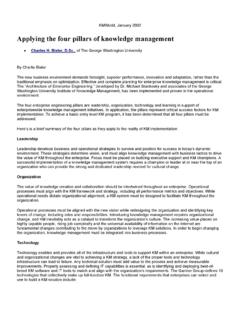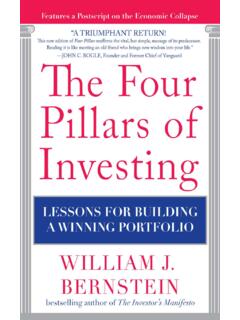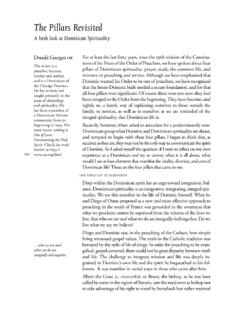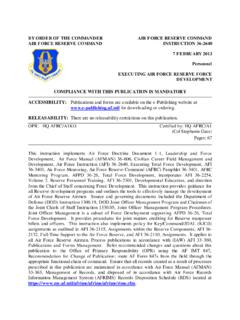Transcription of The Four Essential Pillars of Digital Transformation
1 The four Essential Pillars of Digital practical blueprint for going digitalBy Dr. Ian Thomas and David RosewellIntroduction Digital natives such as Spotify, AirBnB and Uber have delivered more convenient, responsive and engaging experiences for customers and often disrupted entire industry business models while doing so. As Digital natives their intrinsic use of Digital technologies such as cloud, mobile and analytics means that they continue to evolve and scale at speeds that are unthinkable for traditional the last decade a new breed of Digital company has quickened the tempo of business. RosewellHead of Strategy, Change & Assurance, Fujitsu Digital , EMEIAD avid Rosewell helps organizations achieve their business outcomes in the Digital world. His extensive experience in the IT industry spans business development, consulting, and systems delivery across a variety of sectors including government, defense, utilities, retail and financial Ian ThomasChief Marketing Officer,Fujitsu RunMyProcessIan Thomas is a Fujitsu strategist and thought leader, currently serving as Chief Marketing Officer of Fujitsu RunMyProcess.
2 He also maintains a role as a Strategy Director within Fujitsu s Global Software more people, systems and things become interconnected, so the scope to create new and novel Digital value chains rapidly increases. Understanding the impact of these changes and successfully evolving to avoid or exploit disruption is therefore critical to survival. But while there is a broad recognition of the dangers of inaction there is also much confusion; a recent landmark survey by Fujitsu1 found that this lack of clarity results in two in three Digital projects being considered a executives cited a number of roadblocks that were driving this feeling, such as a lack of alignment on Digital priorities, difficulties integrating with existing infrastructure and processes, and a perceived lack of relevant skills. Together these issues have led to a broad range of Digital disconnects - such as fragmented user experiences, disconnected islands of process and data, a slow pace of change and a rise in silos caused by shadow IT all of which create further turmoil and undermine the end-to-end alignment required for there is another way.
3 In this paper we share our experiences of working with companies who are taking an outside-in approach to Transformation , using customer experiences to drive alignment, integrating infrastructure and processes across the whole Digital environment, and transforming IT practices to accelerate changeand empower everyone in the organization to make things , the potential impacts of digitization extend beyond these Digital natives and area pressing issue for businesses across almost every 1 Walking the Digital tightrope, a Fujitsu report , January 2016 Our great Digital gamble But our practical experience has also shown us that there is also no easy path. Most existing businesses have been built and optimized for a pre- Digital world and therefore find themselves weighed down by pre- Digital technology investments, cultures and ways of working. Such organizations cannot merely flick a switch and become Digital overnight - or wait years for large, costly and high risk Transformation programs.
4 They must achieve Digital Transformation using many quick, iterative steps taking an evolutionary path that balances new capabilities and is no great insight to say that enterprises need to go Digital . Recent Fujitsu research has confirmed that most organizations now have a clear understandingof the potential 1: Digital Tightrope Survey question:What do you think are the main benefits to digitalization within your organization?Attraction andretention of talentCustomer retentionand loyaltyCreates newvalue / revenueHelps to protectcore businessBusiness responsivenessto the marketIncreasing workforce productivityGreatercompetitive edgeOthers43%37%27%18%38%37%23% many enterprises take an unbalanced view of this evolution, addressing just one aspect of the necessary Transformation , such as creating new user experiences or introducing new development practices. This fragmented approach results in a range of Digital disconnects, with front-end customer experiences not connected with back-end systems, with development practices siloed between new and old systems, or with business colleagues still frustrated and finding their own solutions beyond the four walls of the great Digital gamble Figure 2: Potential outcomes of a disconnected approach to digitalizationFigure 3: Digital Tightrope Survey question: To what extent do you agree with the following statements on your organization s Digital approach?
5 The success of the majority of Digital projects in my organization is a practical outcome of these problems is an inability to know whether planned initiatives will actually make things better,or create unforeseen new Digital disconnects leading to an overwhelming feeling that Digital projects are simply a in threedigital Transformation projects are a gamble .Beneath the bravado, organizations say Digital success is hindered by complexity, conflicting priorities and a lack of islandsof process and dataShadow IT creating silosSlow pace of changeFragmented user experiencesDigital the odds But not all organizations are trapped by the Digital disconnect. When working with enterprises who are successfully enabling Digital change, we have observeda consistent set of behaviors which can be generalizedto create the foundationsof a repeatable, evolutionary approach. In particular these organizations take an unashamedly end-to-end approach that consists of four interconnected Pillars :Unifythe Digital experienceConnectthe Digital supply chainDeliver at Digital speed and scaleEmpower Digital innovationFully exploiting the capabilities of connected devices to deliver better user experiencesIntegratingend-to-end Digital processes toefficiently deliver outcomesTransforming technology practices to support the continuous delivery and evolutionof offerings at scaleEnablingdistributedinnovation by empowering the organizationFigure 4.
6 The four Pillars of Digital transformationTogether these four Pillars combine to deliver a highly effective outside-in approach to Digital the Digital experience In particular creating experiences that help people get things done is a key weapon in attracting talent, maximizing employee productivity and retaining customers three of the most popular aims cited by organizations in our Digital the consumer-focused approach of delivering individual apps is a poor template for the demands of enterprise mobility. Delivering Digital experiences for the enterprise requires us to go beyond individual apps and provide device and location-independent access to the existing process and information infrastructure of the enterprise. It is maximizing the mobility and connectedness of users that unlocks the value of Digital , not the devices ensure a joined-up Digital strategy, it s important to start with the needs of your stakeholders and work a consistent, connected experience for customers, citizens, employees and partners one that supports people in achieving their business goals, wherever and however they happen to work is the most important factor in satisfying peoples Digital IT and business leaders surveyed said attracting and retaining talentis a key benefit of 5: Digital Tightrope Survey question: What do you think are the main benefits to digitalization within your organization?
7 Enterprise mobility therefore requires three major capabilities: All-round mobility A mobile application should not be tied to a single device type. It should seamlessly adapt to smartphones, tablets, wearables or desktop PCs; it is the mobility of users that delivers the full benefit of Digital processes, not the devices themselves. A common point of access People need a single, device-independent location where they can find and access all of the Digital tools they need to interact with the business; such as an enterprise process store of available applications, to ensure ease of access, visibility of use and consistent governance. A 360 degree view of interactions As people increasingly work across multiple topics they need to gain a dynamic, at a glance view across their ongoing tasks. To replace siloed, app-centric views with one which visualizes their total backlog of work holistically across all processes and the Digital experience At a major European public transport operator, a mobile incident reporting app allows inspectors to file complete incident reports for bus lines from their phones in less than a minute.
8 This has given the maintenance team immediate access to details and photographs of the bus repairs the Digital supply chain Creating a truly Digital business therefore requires the creation of end-to-end process flows which optimize the fulfilment of connected experiences. This requires an outside-in approachto Transformation , reimagining outcomes before moving inwards connecting all of the people, software and things required to deliver the necessary value. And having the capability to constantly extend and evolve these Digital supply chains as customers, partners and suppliers evolve, is a critical skill for the Digital leaders have shown time and again that web-enabled connections between people, systems and devices can transform business modelsand create better many organizations miss the central role ofend-to-end connectivity in this process, instead focusing only on the Digital front-end. Simply creating pixel thin solutions via new apps or slicker websites, however, fails to address the underlying process and integration changes necessary to optimize Digital experiences, simply layering more complexity over existing they would benefit from a balanced approach that effectively combined new technologies with existing 6: To what extent do you agree with the following statements on your organization s Digital approach?
9 My organization would benefit from a more balanced approach to Digital adoption a blending of new technologies with current process change therefore requires three major capabilities: Extending to Digital On-premise systems still make up the critical transactional core of most enterprises and need to be quickly and easily connected to new Digital processes. This requires a combination of integration connectors, API management and manual workarounds, to securely and robustly connect incumbent systems to new Digital flows. Harnessing Digital Building end-to-end Digital flows requires us to mesh our internal systems with people, systems and things that exist beyond the bounds of the organization. The technology infrastructure must therefore connect the whole Digital landscape, making on-demand resources an integral component of end-to-end business operations. Empowering ecosystems Competing in the emerging Digital economy means participating in wider ecosystems with customers and partners.
10 By using a business s APIs to expose its reach, the full power of technology can be bought to major global utility has created a range of Digital processes which connect their complex hybrid IT estate end-to-end. By using integration connectors to modify access rights across a range of on-premise, partner and cloud systems, these processes ensure that data remains secure as employees and external contractors join, change roles or leavethe the Digital supply chain at Digital speed and scale Creating a truly Digital business therefore begins with the use of Digital platforms which support innovation at the new speed of leveraging the increasing industrialization of IT we can createend-to-end modelling and deployment environments which increase speed of delivery, connect to existing legacy systems, and automatically handle the deployment and scaling of solutions to any size of Digital world will not wait for slow, incumbent development processes, technologies and applications to deliver seize market opportunities, satisfy customer demands and innovate at Digital speed.









